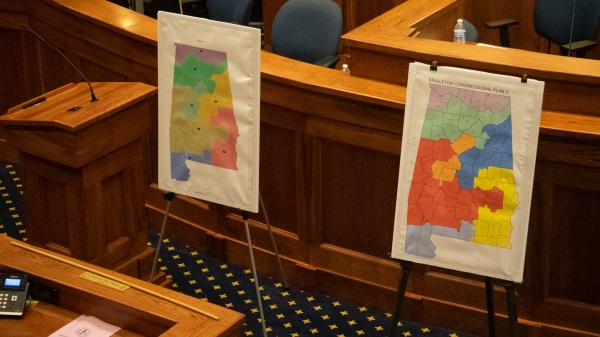A new report card released by nonprofit March of Dimes placed Alabama among U.S. states with the worst maternal health outcomes.
The 2025 March of Dimes Report Card, released in recognition of World Prematurity Day, analyzes data from 2021 to 2024 on the factors contributing to infant mortality and morbidity across the U.S.
The report ranks the 50 states, D.C. and Puerto Rico based on indicators for the health of infants and pregnant and postpartum women.
Nationwide, Alabama ranked as having the 3rd highest infant mortality rate, the 9th highest maternal mortality rate and the 4th highest preterm birth rate. Additionally, the state ranked 43rd in terms of access to adequate prenatal care and had the 13th highest rate of low-risk Cesarean births.
“The numbers are hard to see, but they give us a clear direction for where to focus our work,” March of Dimes Director of Maternal and Infant Health in Alabama Honour Hill said in a statement on Monday.
“In too many parts of our state, families struggle to access high-quality, consistent prenatal and postpartum care and that has lasting effects on moms, babies, and communities,” Hill added. “We’re partnering closely with Alabama Medicaid hospitals, health departments, and local leaders to make care more available and equitable so every Alabama family has the chance for a healthy start.”
Alabama received an F on the report’s preterm birth ranking, alongside seven additional Southern and Appalachian states, D.C. and Puerto Rico.
In the state, 12.7 percent of babies were born preterm compared to 10.4 percent nationwide. In total, 7,379 babies were born preterm in Alabama in 2024.
Mississippi, Louisiana and West Virginia were the only states with higher preterm birth rates.
Alabama’s preterm birth rate has grown by one percent since 2014; however, the rate has been on a slight downward trend since 2021, when it peaked at 13.1 percent.
In 2023, 442 babies died in Alabama before their first birthday, or 7.6 deaths per 1,000 live births, compared to a nationwide average of 5.6. Since 2013, Alabama’s infant mortality rate has decreased by one percent.
Across the U.S., more than 20,000 babies died younger than one year old, with the highest rates of infant mortality concentrated in the South and Midwest regions.
Alabama’s infant mortality rate for babies born to Black mothers came in at roughly 12 deaths per 1,000 live births, or 1.6 times the overall state rate.
In Alabama, 19.3 percent of babies born from 2022 to 2024 had mothers who received inadequate prenatal care, compared to a national average of 16.1 percent. Inadequate prenatal care in the state was twice as prominent among Hispanic mothers and 3 times as prevalent among Pacific Islander mothers.
Mississippi and Arkansas were the only states that displayed higher infant mortality rates than Alabama.
“Behind that static letter grade lies a troubling truth: our nation remains stuck in a maternal and infant health crisis,” March of Dimes Alabama wrote in social media posts announcing the report. “Progress isn’t reaching the families who need it most. We must change the course of this urgent crisis by fighting for policy solutions that make a difference.”
Alongside highlighting maternal and infant health data, the March of Dimes report calls for the implementation of several policies the organization described as “critical” to improving health outcomes.
Alabama has implemented two of the recommended policies: extending Medicaid coverage for one year for postpartum women and implementing a maternal mortality review committee.
In addition, March of Dimes encouraged states to expand Medicaid, reimburse doula care through state Medicaid agencies, require employers to provide a paid option for families on parental leave and require clinicians to perform postpartum depression screenings, reimbursed by the state, for Medicaid-insured women.
The organization reported that Alabama Medicaid covered 24,321 births in 2024, or 42 percent of live births in the state.
Alabama’s poor ranking on the report comes alongside trends March of Dimes described as indicators of deteriorating maternal and infant health accessibility nationwide.
“The story the data tells is sobering: the crisis is not improving, and in many communities, it’s getting worse,” the organization wrote in its summary of the report card.
For the fourth time since 2021, the U.S. earned a D+ average for its preterm birth rate, marking a record-breaking stretch for the nation’s lowest preterm birth score on the annual report card, since its first iteration in 2008.
Overall, 21 states saw worsened preterm birth rates since last year’s report card, 12 saw no change and 19 saw improved preterm birth rates.
March of Dimes also highlighted worsening access to early prenatal care alongside the persistence of racial disparities in preterm birth and infant mortality rates.
“Access to early prenatal care continues to decline, with nearly one in four women beginning care after the first trimester, missing critical opportunities to detect and address risks early in pregnancy,” March of Dimes wrote. “This is not a failure of moms, but rather of systems that create barriers, such as limited providers, transportation, and insurance delays.”
“Rising rates of chronic conditions like hypertension and diabetes further increase risks for both moms and babies. Together, these trends paint a picture of a fragile system where too many families are left behind,” the organization added.
Although the overall U.S. infant mortality rate declined nearly 20 percent over the last two decades, the 2021 to 2023 rate among Black mothers was still nearly twice the national average. Data from the report also indicated that Black mothers were on average more than 4 percent more likely to experience preterm births from 2022 to 2024.
“As a clinician who has seen how much is possible when we get it right, the data is deeply frustrating,” said Chief Medical and Health Officer at March of Dimes Dr. Michael Warren.
“We have known about risk factors for preterm birth, including a history of prior preterm birth, chronic disease, and unequal access to care for years,” Warren continued. “That the national rate remains unchanged while disparities continue to widen means we must deepen our commitment to research, expand maternity care access, and push for better policies that protect our nation’s moms and babies.”




















































